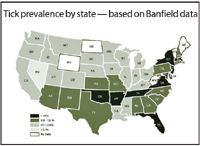Banfield releases new data on parasite trends
Portland, Ore. - New surveillance data compiled by experts at Banfield, The Pet Hospital reveal prevalence trends for internal and external parasite infections and hammer home the need for veterinarians to remain vigilant about promoting preventive care to clients.
Portland, Ore. — New surveillance data compiled by experts at Banfield, The Pet Hospital reveal prevalence trends for internal and external parasite infections and hammer home the need for veterinarians to remain vigilant about promoting preventive care to clients.

New data reveals national hot spots: Banfield collected information from its hospitals nationwide to create this tick infestation prevalence map.
Banfield combed through more than 2.2 million health records collected from feline and canine visits at its 755 hospitals during 2009 to generate the data, and identifed states with the greatest prevalence of flea, tick and heartworm infections.
Internal and external parasites were common in dogs and cats visiting Banfield clinics, and the company says this data review is aimed at helping veterinarians better understand rates of infection.
"As veterinary professionals, it's important that we take the lead in showing pet owners that effective flea and tick control is essential to minimizing the spread of the disease and keeping pets, and their homes, parasite free," says Jeffrey Klausner, DVM, MS, Dipl. ACVIM, senior vice president and chief medical officer for Banfield. "Effective control and prevention of external parasites is the responsibility of both veterinarians and pet owners."
Fleas topped the list as the parasite that most affect dogs and cats during their lifetime. They were the most common parasite in kittens under 6 months of age (18.7 percent), as well as in middle-aged canines (6 percent). Fleas also were the most common external parasite for geriatric dogs and cats, and accounted for infestation rates of 6 percent and 8.5 percent, respectively.
The Southeast United States — with Alabama leading the list — posted the most cases of flea infestations for dogs, with 11.9 percent, while the Northwest had the highest prevalence rates for cats at 17.1 percent. October was identified across the board as the peak month for flea activity, according to Banfield's data, while May was the peak month for ticks. Ticks were most prevalent on dogs (15.9 percent) in the Southeast, with Oklahoma in the lead. The Northeast had the most tick infestations in cats (17 percent), while Massachusetts ranked as the state with the highest prevalence.
"Even though the prevalences are low, ticks carry lots of diseases," Klausner notes. "We want to be sure that veterinarians remember that external parasites are not just a young pet disease."
When it comes to internal parasites, tapeworms were the most commonly found parasite in cats and accounted for an infection rate of about 14 percent at all Banfield hospitals in 2009.
The Southeast had the highest rate (17.9 percent) of internal parasite infections for cats. The highest number of roundworm infections in dogs came from Arizona at 8.1 percent. The rate jumped to 12.5 percent for puppies, Klausner notes.
When it comes to heartworm infections, Mississippi led with a 5.6 percent rate in dogs. Dogs were most likely to test positive for the potentially fatal parasite in the month of February.
"The treatment, control and prevention of internal and external parasites and the diseases they transmit needs to remain at the forefront of veterinary medicine, especially given their zoonotic potential," Klausner adds. "It's very important that the profession continues a preventative care approach to veterinary medicine in order to further reduce disease transmissions among pets and their families."
Podcast CE: A Surgeon’s Perspective on Current Trends for the Management of Osteoarthritis, Part 1
May 17th 2024David L. Dycus, DVM, MS, CCRP, DACVS joins Adam Christman, DVM, MBA, to discuss a proactive approach to the diagnosis of osteoarthritis and the best tools for general practice.
Listen